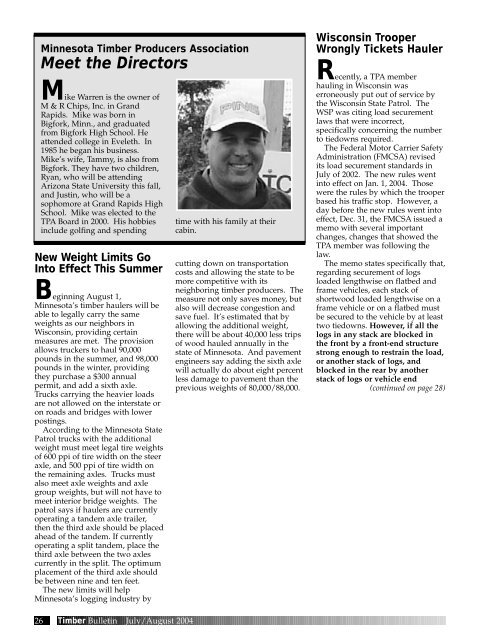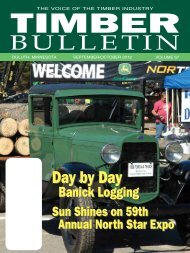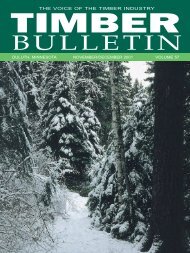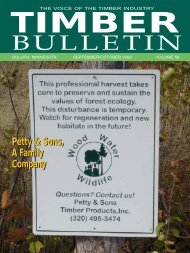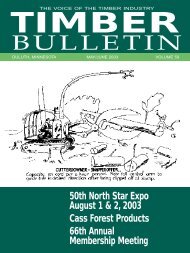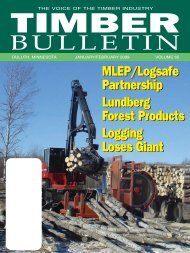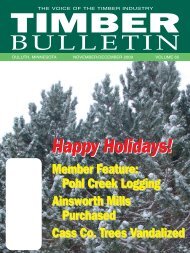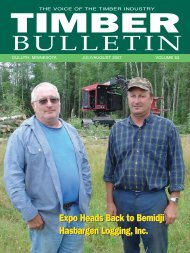Timber Bulletin Jul/Aug - Minnesota Forest Industries
Timber Bulletin Jul/Aug - Minnesota Forest Industries
Timber Bulletin Jul/Aug - Minnesota Forest Industries
You also want an ePaper? Increase the reach of your titles
YUMPU automatically turns print PDFs into web optimized ePapers that Google loves.
<strong>Minnesota</strong> <strong>Timber</strong> Producers Association<br />
Meet the Directors<br />
Mike Warren is the owner of<br />
M & R Chips, Inc. in Grand<br />
Rapids. Mike was born in<br />
Bigfork, Minn., and graduated<br />
from Bigfork High School. He<br />
attended college in Eveleth. In<br />
1985 he began his business.<br />
Mike’s wife, Tammy, is also from<br />
Bigfork. They have two children,<br />
Ryan, who will be attending<br />
Arizona State University this fall,<br />
and Justin, who will be a<br />
sophomore at Grand Rapids High<br />
School. Mike was elected to the<br />
TPA Board in 2000. His hobbies<br />
include golfing and spending<br />
New Weight Limits Go<br />
Into Effect This Summer<br />
Beginning <strong>Aug</strong>ust 1,<br />
<strong>Minnesota</strong>’s timber haulers will be<br />
able to legally carry the same<br />
weights as our neighbors in<br />
Wisconsin, providing certain<br />
measures are met. The provision<br />
allows truckers to haul 90,000<br />
pounds in the summer, and 98,000<br />
pounds in the winter, providing<br />
they purchase a $300 annual<br />
permit, and add a sixth axle.<br />
Trucks carrying the heavier loads<br />
are not allowed on the interstate or<br />
on roads and bridges with lower<br />
postings.<br />
According to the <strong>Minnesota</strong> State<br />
Patrol trucks with the additional<br />
weight must meet legal tire weights<br />
of 600 ppi of tire width on the steer<br />
axle, and 500 ppi of tire width on<br />
the remaining axles. Trucks must<br />
also meet axle weights and axle<br />
group weights, but will not have to<br />
meet interior bridge weights. The<br />
patrol says if haulers are currently<br />
operating a tandem axle trailer,<br />
then the third axle should be placed<br />
ahead of the tandem. If currently<br />
operating a split tandem, place the<br />
third axle between the two axles<br />
currently in the split. The optimum<br />
placement of the third axle should<br />
be between nine and ten feet.<br />
The new limits will help<br />
<strong>Minnesota</strong>’s logging industry by<br />
time with his family at their<br />
cabin.<br />
cutting down on transportation<br />
costs and allowing the state to be<br />
more competitive with its<br />
neighboring timber producers. The<br />
measure not only saves money, but<br />
also will decrease congestion and<br />
save fuel. It’s estimated that by<br />
allowing the additional weight,<br />
there will be about 40,000 less trips<br />
of wood hauled annually in the<br />
state of <strong>Minnesota</strong>. And pavement<br />
engineers say adding the sixth axle<br />
will actually do about eight percent<br />
less damage to pavement than the<br />
previous weights of 80,000/88,000.<br />
Wisconsin Trooper<br />
Wrongly Tickets Hauler<br />
Recently, a TPA member<br />
hauling in Wisconsin was<br />
erroneously put out of service by<br />
the Wisconsin State Patrol. The<br />
WSP was citing load securement<br />
laws that were incorrect,<br />
specifically concerning the number<br />
to tiedowns required.<br />
The Federal Motor Carrier Safety<br />
Administration (FMCSA) revised<br />
its load securement standards in<br />
<strong>Jul</strong>y of 2002. The new rules went<br />
into effect on Jan. 1, 2004. Those<br />
were the rules by which the trooper<br />
based his traffic stop. However, a<br />
day before the new rules went into<br />
effect, Dec. 31, the FMCSA issued a<br />
memo with several important<br />
changes, changes that showed the<br />
TPA member was following the<br />
law.<br />
The memo states specifically that,<br />
regarding securement of logs<br />
loaded lengthwise on flatbed and<br />
frame vehicles, each stack of<br />
shortwood loaded lengthwise on a<br />
frame vehicle or on a flatbed must<br />
be secured to the vehicle by at least<br />
two tiedowns. However, if all the<br />
logs in any stack are blocked in<br />
the front by a front-end structure<br />
strong enough to restrain the load,<br />
or another stack of logs, and<br />
blocked in the rear by another<br />
stack of logs or vehicle end<br />
(continued on page 28)<br />
26 <strong>Timber</strong> <strong>Bulletin</strong> <strong>Jul</strong>y/<strong>Aug</strong>ust 2004


